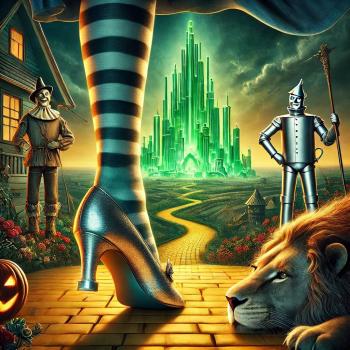 One of the most interesting contemporary religion scholars I have found is Jeffrey Kripal, a tenured professor at Rice University in Houston, Texas. I discovered his work about five years ago, and have followed his career with interest since then. Last year he published a book with the unusual title Secret Body: Erotic and Esoteric Currents in the History of Religions (University of Chicago Press, 2017). A less academic way of saying “erotic and esoteric” is: “I’m going to tell you the sexy secrets of religion!” Along those lines, I appreciate Kripal’s self-admission, looking back over the course of his many books that,
One of the most interesting contemporary religion scholars I have found is Jeffrey Kripal, a tenured professor at Rice University in Houston, Texas. I discovered his work about five years ago, and have followed his career with interest since then. Last year he published a book with the unusual title Secret Body: Erotic and Esoteric Currents in the History of Religions (University of Chicago Press, 2017). A less academic way of saying “erotic and esoteric” is: “I’m going to tell you the sexy secrets of religion!” Along those lines, I appreciate Kripal’s self-admission, looking back over the course of his many books that,
I suppose it is just a bit confusing what a man might be about who started out writing about Tantric traditions in colonial Bengal and Roman Catholic homoeroticism, ended up writing about science fiction and UFO encounters in Cold War America, and never stopped writing about sex” (11).
Agree or disagree with Kripal, he is always interesting.
In many ways he is a contemporary William James (1842 – 1910), the early twentieth philosopher and psychologist, who taught at Harvard. Among James’s many books is The Varieties of Religious Experience, one of those classic books that remains worth revisiting generation after generation. In my early twenties, as I was struggling to free myself from the orthodox dogma of my childhood, I particularly appreciated James’s emphasis on prioritizing firsthand religion (what you know to be true because you have experienced it for yourself) over secondhand religion (what other people tell you is the case).
Importantly, though, at the same time that James was studying the varieties of human religious experience, he also remained interested in the latest scientific research. The same is true of Jeffrey Kripal today. As a historian of religion, he defines religion as “humanity’s millennia-long encounter and struggle with the anomalous, the powerful, the really, really weird stuff that does not fit in, that does not make sense.” But while reflecting on all those strange stories from the history of religion, Kripal remains interested in the latest scientific research such as Quantum Physics—which, it turns out, is also about a lot of anomalous, powerful, weird stuff that doesn’t always make sense. Perhaps you can start to guess where I’m going!
Some critics misinterpret Kripal’s interest in firsthand spiritual experience as meaning that he is anti-science and promoting a return to some sort of pre-Enlightenment Age. The truth is that he is attempting to take both religion and reason seriously. If anything, he is post-Enlightenment, not pre-Enlightenment. He’s not interested in moving backward, but forward in light of all that we know from all the sources available to us.
Here’s one excerpt from Kripal that helps make clear that he is by no means promoting a return to traditional orthodox religion:
As far as I can tell, most of our countless social sufferings and violences arise from the simple fact that we actually believe the social constructions that are our familial, religious, and national identifies. We really think we are our masks and language games. We privilege our religious egos over our humanity, our societies over our species, our cultures over consciousness as such. We have it exactly backward. This book is about reversing that reversal. There is no more urgent political project than this. (4)
Kripal’s work challenges us to loosen our sometimes over-identification with the historically contingent religions, societies, and cultures into which we are born—and recognize our common humanity.
A critical part of what this shift means for Kripal is “the primacy of consciousness over culture” (139). He actually goes further to say that, “Consciousness as such is the new sacred” (400). To begin to unpack that claim, I need to put a few more pieces on the table.
That we humans are conscious—that we are awake and aware of our surroundings—is astounding in so many ways. And the hope of the Enlightenment project (the hope of Modernity) was to take our human awareness of our surroundings and try to explain all of reality through reason and science. But the ‘reason’ we live, not in a modern age but in a postmodern one, is that we discovered through the Enlightenment Project and through science that reality is way bigger and stranger than we humans initially thought. As the scientist J.S. Haldane (1892 – 1964) said about the implications of quantum mechanics: “The universe is not only queerer than we suppose, but queerer than we can suppose.”
From that perspective, let’s go back to Kripal’s definition of religion as “humanity’s millennia-long encounter and struggle with the anomalous, the powerful, the really, really weird stuff that does not fit in, that does not make sense.” And let’s consider what it means to ask if a given claim “makes sense.” That phrase refers to using reason to interpret data from five senses (7). And part of what we have learned is the limitations of that approach: only a small band of the electromagnetic spectrum is visible to our humans eyes, Likewise, there are so many smells, sounds, tastes, touches that are beyond our perception. It turns out the sequence is not merely, “The more we learn, the more we know”—but also a Socratic, “The more we learn, the more we become aware of all that we don’t know—all that we can’t know.” The astrophysicist Neil deGrasse Tyson said it this way: ”The Universe is under no obligation to make sense to you.”
As best we can tell, we live in a 13.7 billion year old universe comprising more than two trillion galaxies—not solar systems, galaxies. That’s already mind-blowing, but the truth may actually be closer to a multi-verse with dimensions far beyond our perceptions. In William James’s words from his book The Pluralistic Universe, “We may be in the universe as dogs and cats are in our libraries, seeing the books and hearing the conversation, but having no inkling of the meaning of it all” (414-415). For me, the takeaway is an invitation to be both more humble and more curious about the ways that reality seems sometimes to be quite strange and weird.
Allow me to be clear as well that nothing I am saying means that we shouldn’t take science seriously. The proof that the scientific method works has a massive amount of evidence behind it: science clearly works—from the stunning new photos from Mars, to the troubling-yet-fascinating headlines about babies being born who have their genomes engineered by CRISPR, to the smart phones in many of our pockets. So when an overwhelming consensus of scientists tells us, for instance, that Climate Change is coming—or in many ways is already here—we are well advised to believe them and change our behavior. But as powerful as the scientific method is, not all experiences are replicable in laboratory conditions.
And as a full-time congregational minister for the past fifteen years, I am in a somewhat unusual position to hear people’s stories of anomalous, powerful, weird, nonsensical stuff that nevertheless happened to them. Like many people, I have also heard these stories from some of my closest friends and family members. But in neither case are those stories mine to share publicly. There are, however, such stories which have been told publicly over the years. Two recent examples from extremely rational public figures are Jill Bolte Taylor’s My Stroke of Insight: A Brain Scientist’s Personal Journey. That book is about Dr. Bolte Taylor’s religious experience when she, a Harvard-trained neuroscientist, had a massive stroke (225). (Her twenty-minute TED Talk is incredible if you don’t have time to read the book.) Or consider Barbara Ehrenreich’s testimony about her adolescent mystical experience in her book Living with a Wild God: A Nonbeliever’s Search for the Truth about Everything (319). As is often the case with these strange experience, Ehrenreich did not talk to anyone about her experience for many years.
Dr. Kripal had his own strange experience while doing research in Calcutta. He unexpectedly awoke one night to experience himself as Shiva lying prostrate beneath the feet of the goddess Kali (51). As with the case of Bolte Taylor and Ehrenreich, this strange experience has never been repeated in Kripal’s life, but it was powerfully formational. There are additionally often (not always) erotic and/or traumatic components to these mystical experiences, which is where the “sexy secrets” part of Kripal’s work comes in.
To give you a story from my own life, in my senior years of college when I was almost through completing the last page of a form to apply to a particular graduate school, I had a sudden, unexpected moment of clarity that, “This is not for you.” I didn’t hear a voice per se. But I did distinctly ‘receive’ that message in a way that I felt — viscerally, definitively — in my body, and I did not apply to that graduate school.
I don’t take that experience to mean that some Santa-Claus-meets-Zeus-type God exists and was speaking to me, but I do take it—along with many other people’s experiences—to mean that our human consciousness is quite a curious and uncanny thing sometimes. And although we are for the most part out of our league in the grand scheme of things—although for the most part we are, as James, said “in the universe as dogs and cats are in our libraries, seeing the books and hearing the conversation, but having no inkling of the meaning of it all”—occasionally ‘knowledge‘ beyond our senses ‘breaks through,’ so to speak.
At this point, we are ready to begin explicitly connecting back to those earlier quotes about “the primacy of consciousness over culture” and “consciousness as such is the new sacred.” As a historian of religion, Kripal urges us not to get lost in the culturally conditioned ways that people interpret the strange experiences they sometimes have. (Christians tend to interpret these experiences as confirming Christianity, Hindus tend to interpret them as confirming the Hindu tradition, etc.) But when you compare these experiences across time and culture, a pattern emerges of all these “varieties of religious experiences” arising as a part of human consciousness.
From a classical, Enlightenment, materialist perspective, our consciousness (our awareness) is completely generated by our brains. So when our brains go, we go. (“Lights out!”) That is likely true at least in part. Our brains matter. But I also think Carl Jung was on to something with his idea of the Collective Unconscious: that part of what our brains are doing is tuning in to something ‘more’ that is larger than ourselves.
In Jung’s metaphor, our ego (the part of ourselves that we are consciously aware of) is merely the tip of an iceberg, the 10 percent of the iceberg that is floating above the surface of the ocean. But it wasn’t the tip of the iceberg that sank the Titanic; it was the other 90 percent of the iceberg underneath the surface. For Jung, that 90 percent of the iceberg underwater represents our individual unconscious. The much larger ’collective unconscious’ is the ocean: “the sea of mind and being out of which the individual psyche, that is, the person, ‘freezes’ into hard form and and comes into existence, at least for a time, before it is melted back into the ocean…” (195).
I should also hasten to add that it was neither Jeffrey Kripal nor any other spiritual mystic who first opened my mind to how truly weird and astoundingly strange reality seems to be. It was a scientist, the Columbia University professor of theoretical physics Brian Greene (1963-). I highly recommend his 2003 PBS series The Elegant Universe. It blew my mind! (It was based on his book of the same title that won the Royal Society Prize for Science Books and was a finalist for the Pulitzer Prize Nonfiction, but I recommend the PBS series because the visualizations make the concepts much more accessible.)
Greene’s presentations about “spooky action at a distance” and non-linear time were as wild as the wildest writings of any religious mystic I have ever read (237). Kripal says it this way:
The physicists go on and on about Big Bangs, ghost universes, a multiverse, multiple dimensions, entangled telepathic particles, God particles, nonlocality, retrocausation, even tiny invisible “strings”…. But we [humanities scholars]? We allergically avoid all our remarkable stuff, all those religious experiences that strongly suggest that quantum effects do scale up to human experience—all that mystical interconnectedness, all those entangled people who somehow instantly know what is happening to a loved one (or a beloved pet) a thousand miles away (nonlocality), or, foresee, what is about to happen (retrocausation). Instead, we go on and on about how we are all locked into our historical contexts, how religion is only about dubious power or bad politics, or…evolutionary adaptations, how these fantastic stories are all just ‘anecdotal’ statistical flukes or perceptional delusions…. (360)
By all means, religion is sometimes all those things, but that is not all religion is, especially firsthand religion. Similarly, sometimes experiences are delusions or the deliberate, cynical products of frauds, hucksters, charlatans, fakes, or snake oil salesmen–but not all of them, at least not in my experience.
I also readily confess that this subject matter is quite strange, but so too, in my experience, is this reality in which we find ourselves. To leave the last words to Kripal, “What I do know is that any vision short of something so fantastic is simply too small. Any story smaller is not worthy of who and what we really are” (421).
The Rev. Dr. Carl Gregg is a certified spiritual director, a D.Min. graduate of San Francisco Theological Seminary, and the minister of the Unitarian Universalist Congregation of Frederick, Maryland. Follow him on Facebook (facebook.com/carlgregg) and Twitter (@carlgregg).
Learn more about Unitarian Universalism: http://www.uua.org/beliefs/principles












